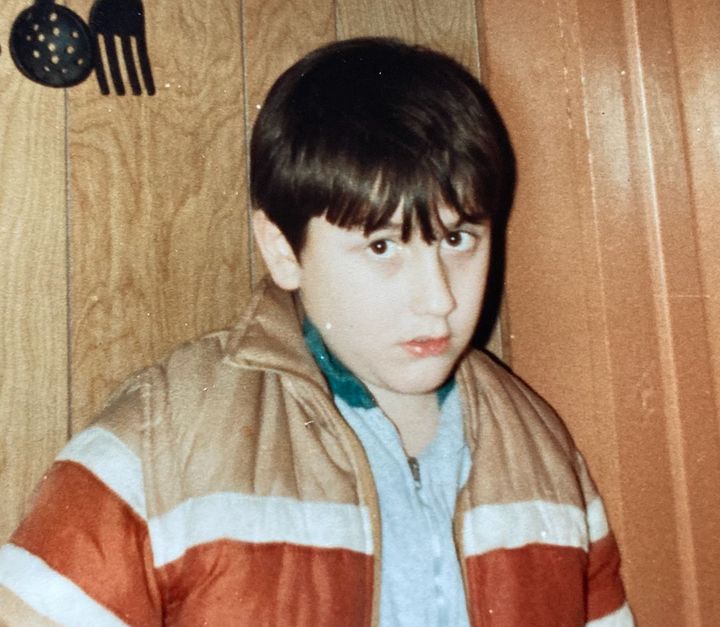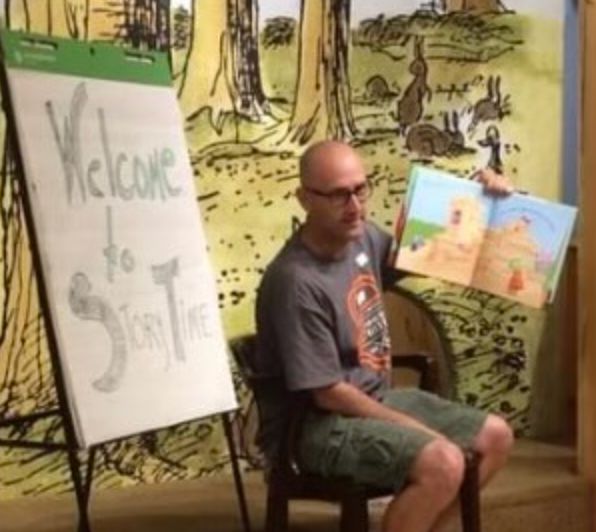
One particularly stressful day a few years ago, while driving to an important work event, I was seized with a severe bout of tics. This was not unusual for me. I’d been ticcing nearly all my life, and stress always exacerbated my tics.
On this day, my snorts and jerks were so out of control that I rear-ended a car. That’s when I finally visited a neurologist. I needed to know, literally, what made me tic. What he told me — “You have Tourette syndrome” — came as a shock.
It was also a relief. For as long as I can remember, I’ve had the characteristic vocal and motor tics associated with the condition. Secreting them away in my mental lockbox, burying them well out of sight of others, was how I dealt with them. A diagnosis brought clarity, and it meant that I could deal with my tics in a healthier way — or so I thought.
I grew up in a small western New York town in the 1980s, those heady days of ozone-depleting hair spray, goofy mullets and syrupy synth pop. In my rural community, very few people knew what Tourette was. I certainly didn’t.
When I was a teenager, a television program, possibly “60 Minutes,” aired an episode on the subject that I watched with my mom. It featured a young man who shouted obscenities in some large American city. By that time I’d been ticcing for years — in fact, I’d already been hiding my tics for years. But I didn’t recognise myself in this program, because never, not once, did I swear or shout in public.
When I was in elementary school, a teacher once stopped class to tell me to quit making noises and “doing that thing you’re doing with your head.” She actually demonstrated “that thing” in front of my classmates because I was apparently annoying her and disrupting her lesson. Every head turned my way, and I put mine down, humiliated. I could not tell her that I couldn’t help myself.

In birding, there’s something called a “spark bird” — the bird that, when you first see it in the wild, truly gets you hooked on birding. But this was my spark moment, when I realised my tics were not “normal” and that I needed to hide them if I wanted to be normal.
If my mom made any connection between that kid we saw on TV and me, she didn’t mention it, and my parents didn’t take me to a neurologist to have me checked out. Because of that TV program, I assumed, wrongly, that having Tourette meant shouting obscenities in public. I learned that this version of Tourette is called coprolalia and, according to the Centres for Disease Control and Prevention, it “only affects about 1 in 10 people with Tourette.” It is not as common as popular media likes to portray it.
For me, ticcing has always meant a near-constant urge to do things with my body. “Urge” may not be the right word for these head jerks, blinks, snorts, grunts, throat clearings, tongue clicks, etc., but it’s the best I’ve got. From the moment I wake up to the moment I fall asleep, my body seems to have a will of its own. In any given hour, I probably tic at least 100 times. During periods of great stress, like when I rear-ended that car, my tics are like a parasitic fungus that assumes total control over my body.
Nobody wants to twitch or make weird noises in public — to be the person people crane their necks to see. What’s wrong with this guy? you imagine them thinking. After getting called out by my teacher, I only wanted to blend in — to become invisible — because when you’re in elementary school, you don’t want to be seen as a freak. You want to be like everyone else.
I couldn’t stop ticcing, but I discovered that I could make it less obvious. To shield myself from shame and embarrassment, I developed an arsenal of tic-hiding strategies. Instead of jerking my head, I would put my hand underneath the table and waggle my fingers or ball my fists repeatedly. Instead of snorting or chuffing — obvious and strange sounds — I’d click my tongue softly, like an irregular metronome.
These tricks satisfied my near-constant urge to tic and kept me mostly hidden from view. I wasn’t bullied or teased in school, as kids and adults with tics often are, but I probably would have been if I hadn’t learned how to control my tics.
I’ve been using these tricks ever since.
When I’m out in public today, I’m keenly aware of my internal pressure to tic, but I’ve become adept at suppressing it, bottling it up and capping it tight. At home, where I’m free to be myself, it’s a very different story. My tics come and go.
Six months ago, I began squirting air from my mouth the way someone might blow hair off their face; a few weeks later, I started hocking as though to spit a loogie. Like uninvited guests overstaying their welcome, both tics remain with me as I write these words. Sometimes a particular tic will go away only to return a year later, like an exasperating big brother who’d gone off to college and come home with a sly grin and a shaggy beard.

There is no cure for Tourette — all you can do is try to manage your tics. There are treatments available, ranging from antihypertensives like guanfacine and clonidine to alternative options like the antipsychotic drugs risperidone and Abilify. But I’d honestly rather have tics than the potential side effects these drugs can cause.
When I was first diagnosed, I tried guanfacine and I’d wake up in the middle of the night so parched that it was like I’d swallowed sand; my sleeplessness felt more like a punishment, especially since the drug didn’t even control my tics, so I quit taking the pill. Since then, I’ve chosen no other treatments, though I recently learned of a promising option I will try called “comprehensive behavioural intervention for tics,” or CBIT. This doesn’t involve any drugs. Instead, it trains you to change your behaviors and tic less.
Researchers estimate that between 350,000 and 450,000 Americans have Tourette syndrome, while roughly 1 million have other persistent tic disorders. There’s said to be insufficient evidence to determine the number of adults with Tourette because many people simply outgrow their tics by late adolescence. According to the Tourette Association of America, the condition “occurs in 1 in 160 (0.6%) school-aged children, although it is estimated that 50% are going undiagnosed” (italics mine).
A 2022 survey by the group suggested that 1 in 10 children with a tic disorder “attempted suicide at least once during the past 12 months.” That’s a scary number, and it speaks to how difficult it is for many people with tics to feel comfortable in their own bodies. I’m glad that kids (and their parents) who are diagnosed with Tourette today now have resources available to them — including a supportive community — to feel less stigmatised or ostracised by this awkward thing in their lives.
I did not outgrow my tics. Because it’s hard to admit publicly something I’ve always internalised and associated with shame, few people know this part of me. Even if you’re not bullied or harassed, hurt and humiliation run deep; they form scars that are easily scraped off.
How many other adults fly under the radar, as I do? Who, like me, never outgrew their tics but developed strategies for concealing them? Who didn’t benefit from services that the Tourette Association of America offers, or the wealth of research being done today? Who struggled to form truly lasting friendships for fear of being exposed as someone with tics?

Apart from the nuisance of having tics, I live what society would likely deem a “good” and “regular” life. I have a wife, a child, a great job, a house, and a creative life as a writer and translator. I have Tourette, but Tourette doesn’t have me — though my wife would certainly disagree with this. When we got together 25 years ago, I suppressed my tics in front of her, but you can’t hide something like this from someone you live with. I no longer try. Even on those nights when my ticcing body keeps her up, she’s supportive.
Since I’ve spent a lifetime hiding my tics, I’ve become successful at blending in, even when I’m meeting people for work or on stage in front of an audience, giving a reading or interviewing authors. But I’ve also experienced moments of deep loneliness. Retreating into yourself is a good way to not be publicly embarrassed, but you pay a price. Eventually, you end up feeling like a ghost in your own life — known to no one but yourself and a few carefully curated individuals whom you trust. I don’t make friends easily.
Later this year, I will publish my debut novel, “The Book of Losman,” after translating more than a dozen novels from Danish and writing countless unsold manuscripts over the past 30 years. It’s about a literary translator, like me, with Tourette, but that’s where the similarities end. It’s a speculative fiction about a man named Losman who lives in Copenhagen, Denmark, and gets involved in an experimental drug study to relive childhood memories in the hope of finding a cure for his Tourette. Why not? The beauty of fiction is that you can imagine anything you want, provided the world you create is believable.
In real life, I can’t go back in time to reassure the little kid who got called out in elementary school, but I’m old enough to understand something he couldn’t: “Normal” is a highly subjective word, one laced with many assumptions. At nearly 50 years old, my tics (and the need to control them) are ingrained in the very fabric of my being. Even after publishing this essay, I will continue to hide my tics in public. Why? The stigma is a great burden.
The line between dignity and humiliation is, in the end, a thin one — at least for me. I truly admire those in the younger generation, who can go on TikTok or YouTube and put themselves out there for the world to see. That’s not for me. But by sharing my story here, what I can do is help normalise Tourette and other tic disorders. People like me, we’re all around you. All that we ask for is what every human being deserves: to live a judgment-free life.
K.E. Semmel is a writer and translator of more than a dozen novels from Danish and Norwegian. His fiction and nonfiction have appeared in Ontario Review, Literary Hub, The Writer’s Chronicle, The Southern Review, The Washington Post and elsewhere. “The World and Varvara” by Simon Fruelund is his most recent translation. His debut novel, “The Book of Losman,” will be published in October 2024 (Santa Fe Writers Project). Find him online at KESemmel.com and on his Twitter/X page, @KESemmel.